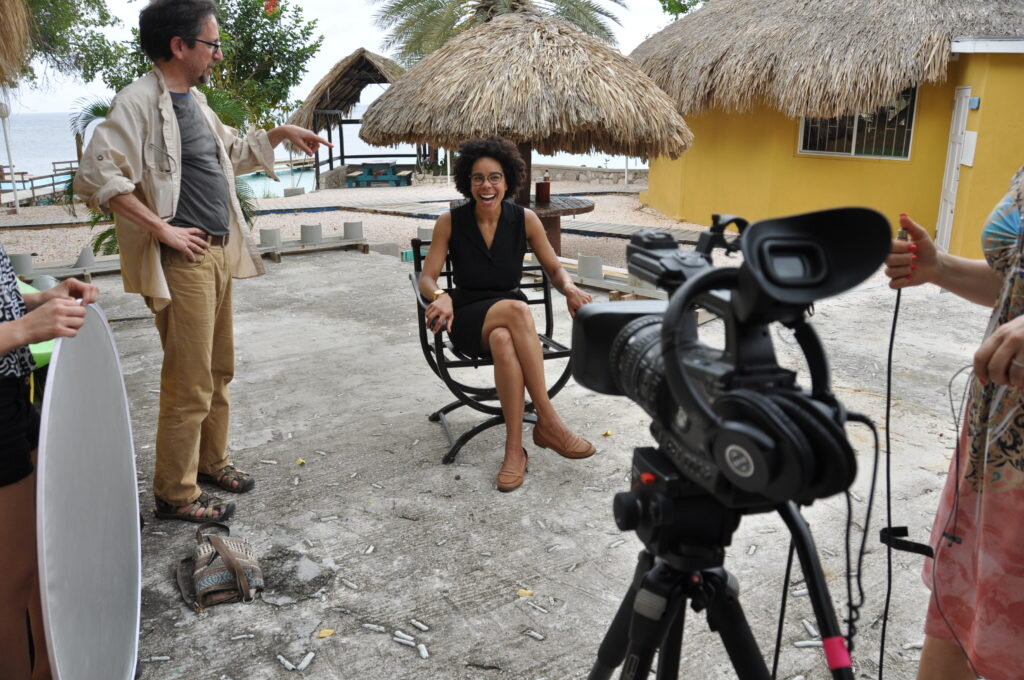Hope for Curaçao’s Corals and the Future of Journalism
Originally published on the (now archived) National Geographic blog.
May 28, 2015
Ayana with Andy Revkin while being interviewed on-location in Curaçao for the Pace Coral film. (Photo: Yumeng Ji, Pace University)
When New York Times Dot Earth reporter Andrew Revkin got in touch with me seeking a documentary topic for the environmental journalism course he co-teaches at Pace University , he walked right into my trap. I rarely pass up an opportunity to twist someone’s arm to share optimistic stories of ocean conservation (#OceanOptimism!). Curaçao has some of the healthiest coral reefs remaining in the Caribbean, and having conducted most of my dissertation research there, I knew there was an important and complex story to tell.
And tell it they did! Revkin’s students spent their spring break in Curaçao interviewing scientists, politicians, environmentalists, and fishermen to understand what has led to the decline of Curaçao’s reefs and what could turn that around. With minimal background in marine biology, conservation, and policy, they dug in, worked extremely long hours, and put together this story.
The 20-minute film – “Curaçao’s Coral Challenge – Reviving the Rainforests of the Sea” – features marine biologist Dr. Mark Vermeij, Director of Science at Curaçao’s Carmabi Foundation, Mr. Faisal Dilrosun of Curaçao’s Ministry of Environment, Curaçao Senator Glen Sulvaran, marine biologist Dr. Aaron Hartman, geologist Dr. Bruce Fouke, and me. Each of us present an important piece of the story. My piece is about solutions — creating a brighter future.
As I describe in my interview (and am quoted in Revkin’s article “Film Explores Curaçao’s Efforts to Become a Caribbean Haven for Coral,") I think that Curaçao has been really lucky so far. Curaçao has some of the healthiest reefs in the Caribbean, and that is not because of marine reserves, that’s not because of strong pollution controls, it’s not because coastal development hasn’t happened. It is because consistent currents flush pollution out, they are far enough south to miss most of the hurricanes, and the north shore hasn’t been developed. So figuring out how to transition from luck to deliberately protecting the reefs is the challenge right now.
Under the Blue Halo Initiative, the Waitt Institute is partnering with the government of Curaçao to rise to this challenge. We are supporting the development of science-based, community-driven sustainable ocean management. Blue Halo Curaçao is aimed at empowering the island’s residents to reverse the trend of coral reef degradation and restore their ocean. They have the will and we have the tools.
Speaking of tools, those that these Pace University students gained from this course are myriad. Courses like this foster teamwork, provide new perspective on the world, push students to stretch beyond their past experiences, and, perhaps most importantly, set a high standard for what journalism should entail. Many Pace students are the first in their family to attend college (and for one student, this course was the first time on an airplane), making this immersive exposure to the world of journalism even more valuable. It was a pleasure to work with them as they explored environmental reporting and filmmaking.
Thank you and kudos to Andy Revkin, Professor Maria Luskay, and their students for sharing the story of the decline and potentially bright future of Curaçao’s coral reefs. All of you readers, please watch and share this well-told story of hope – not just hope for the reefs, but also for the future of journalism.
For more background on the making of the film see the students’ course blog “Lights, Camera, Coral!”, and Revkin’s DotEarth articles:


